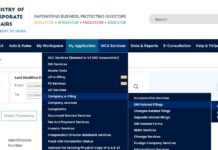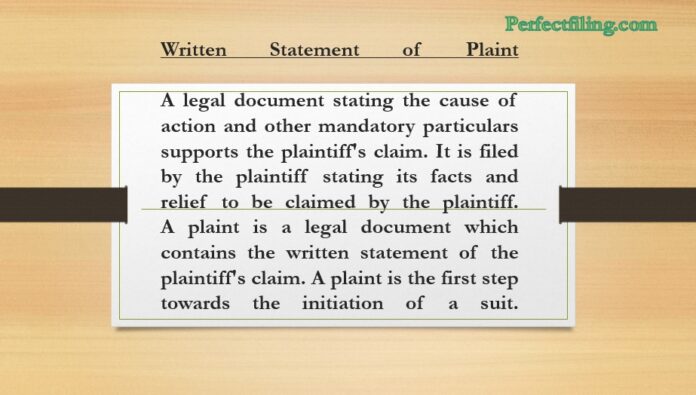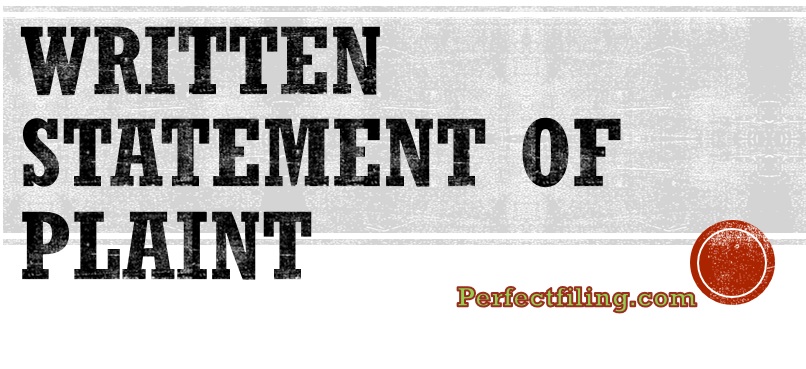Written Statement of Plaint is a defense statement comprising all material facts ad other details against the plaint. A legal document stating the cause of action and other mandatory particulars supports the plaintiff’s claim. It is filed by the plaintiff stating its facts and relief to be claimed by the plaintiff. A plaint is a legal document which contains the written statement of the plaintiff’s claim. A plaint is the first step towards the initiation of a suit.
IN THE COURT OF CIVILJUDGE, (Senior Division)…….
Suit no . . . . . . . . . of 20. . .
IN THE MATTER OF:
Mr. A
S/O ______________
R/O_______________ … Plaintiff
VERSUS
M/s XYZ
CIN:
Regd. Office: _______________ …Respondent/ Defendants
Through its Director and Authorised Signatory,
Shri Mr. B
S/O______________
R/O______________
Plaint filed on behalf of the plaintiff under Order VII Rule-10 and long cause title.
1. That Plaintiff Mr. A, S/o. ________, ______ years, Hindu, job, residing at ___________
2. That Respondent/ Defendants is M/s XYZ incorporated under the Companies Act, 2013
and having its registered office of__________________________________________
through its Director and Authorised Signatory is Mr. B, S/o. ______aged _______ years,
Hindu, Job, residing at _________________________.
Written Statement of the Respondent under Order 8 Rule 1
(or Written Statement on behalf of all the Respondents)
The respondent(s) respectfully state(s) as follows : –
(1) Para no. 1 of the plaint is purely based on facts and defendant do not any
objections on the same.
(2) Para no. 2 of the plaint is purely based on facts and defendant do not any
objections on the same.
(3) Para no. 3 of the plaint is purely based on facts and defendant do not any
objections on the same.
(4) Para no. 4 of the plaint is denied and not admitted on the basis of the following
grounds as:-
1. The Plaintiff was on Leave.
2. Claims to be on medical leave.
3. No documents / fitness certificate submitted.
4. Internal Policy without adequate proofs salary cannot be credited.
5. Employee has already exhausted the limit of leave which are granted
by an Organisation in a calendar year.
6. In case of proof are submitted salary for the days when he has reported.
(5) Para no. 5 of the plaint is purely based on facts and defendant do not any
objections on the same.
(Facts constituting cause of action)
(6) Para no. 6 of the plaint is purely based on facts and defendant do not any
objections on the same.
(7) Para no. 7 of the plaint is purely based on facts and defendant do not any
objections on the same.
(8) Para no. 8 of the plaint is purely based on facts and defendant do not any
objections on the same.
(9) Para no. 9, the plaint is denied and not admitted on the basis of the following
grounds as:-
1. The plaintiff has been well informed verbally and via email that due to lockdown,
Respondent will not able to pay his salary until 30th May 2021. He was agreed to
that he has his consent over email.
2. The plaintiff has not admitted it in the plaint. And Said Plaintiff has been filed a
mischievous ground, so no claims of court fees can be entertained.
3. The Plaintiff was on Leave. Claims to be on medical leave. No documents / fitness
certificate submitted.
4. Internal Policy without adequate proofs salary cannot be credited.
5. Employee has already exhausted the limit of leave which are granted by
organisation in a calendar year. In case of proof are submitted salary for the days
when he has reported.
(10) Para No 10 of the plaint is purely based on facts and defendant do not any
objections on the same.
(11) Para No 11 of the plaint is purely based on facts and defendant do not any
objections on the same.
(Jurisdiction/Optional)
Respondent has committed to pay the salary as per terms and conditions agreed by
__/__/_. Respondent already has consent from the plaintiff. The respondent
therefore prays that the suit be dismissed with costs.
VERIFICATION
Verified at [Place] on this [Date:_____…] that the contents of paras 1 to 11 of the
plaint are true to my knowledge derived from the records of the Plaintiff maintained
in the ordinary course of its business, those of paras1 to 11 are true on information
received and believed to be true and last para is the humble prayer to this Hon’ble
Court.
Dated: __/__/___
Advocate for the Defendant Defendant
List of the document filed
Copy of the email having consent to delay the salary.
EXAMINATION OF THE PLAINT
1. Examination of plaints/petitions/applications etc:- On the presentation or receipt of a plaint, the Court should examine it with special reference to the following points, viz:-
(i) Whether the plaint contains the particulars specified in Order VII, Rule 1, and conforms to the other rules of pleadings in Orders VI and VII and rules made by the High Court
thereunder;
(ii) Whether there is, prima facie, any non-joinder or mis-joinder of parties, or mis-joinder of causes of action;
(iii) whether any of the parties to the suit are minors and, if so, whether they are properly represented as laid down in Chapter 1- M (d) of this volume;
(iv) whether the plaint is duly signed and verified;
(v) whether the suit is within the jurisdiction of the Court or must be returned for presentation to proper Court (Order VII, Rule 10 );
(vi) whether the plaint is liable to be rejected for any of the reasons given in Order VII, Rule 11;
(vii) whether the documents attached to the plaint (if any) are accompanied by lists in the prescribed form and are in order;
(viii) whether the plaintiff has filed a proceeding containing his address for service during the litigation as required by Rule 19 of Order VII as framed by the High Court.
(ix) In money suits, whether the plaintiff has stated the precise amount the claims;
(x) Whether the plaintiff has stated in his plaint regarding the documents on which he relies his claim and are not in his possession and a statement in whose possession or power they are;
(xi) Whether the plaintiff has filed the address of the party in the prescribed form.
2. Pleadings:- The provisions of the Code, with regard to the pleadings (which term includes the plaint and written statements of parties) should be carefully studied. The principal rules of pleadings may be briefly stated as follows:
(a) The whole case must be stated in the pleadings, that is to say all material facts must be stated (Order VI, Rule 2).
(b) Only material facts are to be stated. The evidence by which they are to be proved is not to be stated (Order VI, Rules 2, 10, 11 and 12).
(c) The facts are to be stated concisely.
(d) It is not necessary to allege the performance of any condition precedent; and averment of performance is implied in every pleading but a non-performance of condition precedent, if relied on, must be distinctly stated (Order VI, Rule 6).
(e) It is not necessary to set out the whole or any part of a document unless the precise words thereof are necessary. It is sufficient to state the effect of the document as briefly as
possible (Order VI, Rule 9).
(f) It is not necessary to allege a matter of fact which the law presumes, or as to which the burden of proof lies on the other side (Order VI, Rule 13).
(g) When misrepresentation, fraud, undue influence, etc., are pleaded, necessary particulars must always be given (Order VI, Rule 4).
(h) When a suit is prima facie time-barred, the ground on which exemption is claimed must be stated (Order VII, Rule 6).
If the plaint is prolix (lengthy) or indefinite or omits to give the necessary particulars or to specify the relief claimed precisely or is defective in any other respect, it should be returned to the party or his counsel for such amendment as may be necessary in the actual presence of the presiding officer after he has signed the endorsement. The Court has wide powers in this respect (see Order VI, Rule 16 and 17). Where amendment is directed, an order should be recorded by the Judge indicating the particulars about the necessary
amendment and fixing a date for filing the amended plaint.
3. Non-joinder and mis-joinder of parties and causes of action:-
(a) Attention is drawn to the provisions of law contained in Order I and II of the Civil Procedure Code relating to non-joinder of parties and mis-joinder of causes of action and parties and as to representative suits:-
(i) Joinder of parties:- Order I, rule 1 and 3 provide in what case several plaintiffs or defendants may be joined in one suit.
(ii) Representative Suits:-Order I, rule 8 provides that when there are numerous persons having the same interest in one suit, one or more of such persons may sue or defend on behalf of all with the per- mission of the Court.
(iii) Objections as to non-joinder or mis-joinder:- Order I, rule 9 lays down that no suit shall be defeated by reason of mis-joinder or non- joinder of parties and Order I, rule 13 and Order II, rule 7 lay down that objections as to non-joinder or mis-joinder of parties or causes of action, etc., should be made at the earliest stage of the case.
(iv) Joinder of cause of action:- Order II, rules 3-5 provide in what cases several causes of action may be joined in one suit.
When an objection duly taken with regard to mis-joinder of causes of action is allowed by the Court the plaintiff should be permitted to select the cause of action with which he will
proceed and the Court should grant him time to amend the plaint by striking out the remaining causes of action. The Court should also give the plaintiff time within which to submit amended plaints for the remaining causes of action and for making up the Court fee that may be necessary. (Order II, Rule 8, Civil Procedure Code).
(v) Separate trial:- Order I, rule 2 and Order II, rule 6 provide for power of the Court to order separate trials if the joinder of several plaintiffs or several causes of action is inconvenient.
(vi) Striking out and adding parties:- Order I, rule 10 gives power to the Court to strike out unnecessary parties and add necessary parties.
(b) Necessary parties:-Suits for inheritance, partition or declaration of right in order to effect a partition, contribution, redemption, foreclosure, administration of property, dissolution and winding up of a partnership, and the like, cannot be properly disposed
of unless all persons interested in the matter are before the Court. Therefore, in cases of this description, if it appears that any necessary parties, have not been joined, the plaintiff should be ordered to joint them.
4. Signing and verification:-The plaint must be signed by the plaintiff, or, if by reason of absence or other good cause the plaintiff is unable to sign it, by his duly authorised agent. It must also be signed by the plaintiff’s pleader (if any) and be verified by the plaintiff, or by some other person proved to the satisfaction of the Court to be acquainted with the facts of the case.
The personal attendance of the plaintiff in Court for the purpose of verification is un- necessary. The verification must, however, be signed by the person making it.
5. Jurisdiction:- The jurisdiction of a Court depends upon the nature and value of the suit. (For detailed instructions see Chapter II on “Jurisdiction of Courts” and Chapter III on “Valuation of Suits “). If a suit is not within the jurisdiction of the Court, the plaint must be
returned in the presence of the Presiding Officer for presentation to proper Court. In such cases the presiding Officer must record on the plaint his reasons for returning it along with the other particulars mentioned in sub-rule (2) of Rule 10 of Order VII.
6. Rejection of plaint:- If the plaint discloses no cause of action, or is barred by any law on the statements made therein, or if the relief claimed is under-valued or the plaint is not sufficiently stamped and the plaintiff fails to correct the valuation or pay the deficiency in the Court-fee within the time fixed by the Court the plaint should be ‘rejected’ under Order VII, Rule 11 reasons being recorded by the Presiding Officer in support of the order.
It should be noted that the correct order in such cases is to ‘reject the plaint’ and not ‘dismiss the suit’. The rejection of a plaint does not preclude the institution of a fresh suit on the same cause of action, provided of course, it is not otherwise barred (e.g. by
limitation, etc.) by that time.
7. Comparison of copies of account:- Copies of any shop book or account produced should be compared with the original by Chief Ministerial Officer of the Court and the shop book or account should then be returned after marking the entries relied upon (Order VII, Rule 17).
When a shop book or other account written in a language other than English or the language of the Court is produced with a translation or transliteration of the relevant entry, the party producing it shall not be required to present a separate affidavit as to the correctness of the translation or transliteration but shall add a certificate on the document itself, that it is a full and true translation or transliteration of the original entry, and no
examination or comparison by the ministerial officer shall be required except by a special order of the Court.
8. Address of the parties:- The proceeding containing address for service is intended to facilitate the service of processes throughout the litigation (including appeals, etc.) and it is, therefore, important to see that it is duly filed at the outset according to this rule. Failure to comply with the rule is liable to be punished with dismissal of the suit but such an order may properly be passed in extreme cases when the failure is intentional and contumacious.
9. Land Suits:- If the plaint relates to agricultural land and the plaintiff is illiterate, it should be scrutinised with special care, according to the following directions:-
(i) The Presiding Officer shall ascertain by careful examination of the plaintiff or his agent, whether the prayer in the plaint corresponds in all particulars with the exact relief which the plaintiff orally describes himself as seeking. If the oral statements of the plaintiff or his agent are at variance with the written description of his claim, the plaint shall, in his or his
agent’s presence, be returned for amendment, and no amended plaint should be accepted until the Court is satisfied that it correctly expresses the claim which the plaintiff desires
to establish.
(ii) Every such plaint shall be accompanied by a statement, in the prescribed form setting forth the particulars relating thereto recorded in the Settlement record and in the last Jamabandi. This statement shall be verified by a signature of the Patwari of the Circle in which the land concerned is situate. Where by reason of partition, river action or other cause, the entries in the Settlement record and in the last Jamabandi do not accord, a brief explanation of the reason should be given in the column of remarks. Where the suit is for a specific plot with definite boundaries, it shall also be accompanied by a map, drawn to scale, showing clearly the specific plot claimed, or in relation to which the decree is to be made and so much of the fields adjoining it, also drawn to scale, as may be sufficient to facilitate identification. The specific plot and adjoining fields shall be numbered in accordance with the statement and the map shall be certified as correct by the Patwari or other person who prepared it. Where, however, the suit is for the whole of one or
more khasra numbers as shown in the Settlement map, or a share in such numbers, and not for a specific portion thereof no map will be required unless it is necessary for other reasons to show the boundaries of such khasra numbers.
10. Suits for recovery of money, mesne profits and accounts:- If the plaintiff seeks the recovery of money, the plaint should state the precise amount, as far as the case admits. In a suit for mesne profits or unsettled accounts it is sufficient to state the amount
approximately.
11. Suits by or against firms:-Suits by or against firms should be in the form prescribed in Order XXX. An explanation has been added by the High Court to Rule I of Order XXX, making it applicable to joint Hindu trading partnerships. (Notification No. 2212-G., dated 12th May, 1909).
12. Copies or concise statements of plaints:- When the plaint is admitted (after such amendment as may be found necessary), the plaintiff should be required to give as many copies of the plaint on plain paper as there are defendants, for being supplied to them. If
the plaint is long, or the number of defendants is large, the Court may permit concise statements of the plaint to be supplied instead. Such copies or concise statements must be examined by the chief ministerial officer and signed, if found correct (Order VII, Rule 9).
13. Parcha Yaddasht.:- When a plaint or petition is admitted and a date fixed for summoning of the other party or for any other purpose a memorandum (parcha yaddasht) on strong paper in the form given below duly filled in shall be given to the plaintiff or the petitioner or his agent if he is illiterate and not represented by counsel.
Form of Parcha Yaddasht.
IN THE COURT OF THE________________________AT Court____________
HOURS FROM _______________AM____________TO _________________
PM (Suit ____________) Civil Appeal________) No. ______________of 19
(Miscellaneous Application)
| Parties | Date of receipt | Date fixed for hearing | Place at which attendance is required |
Purpose for date is fixed | Remarks |
| A. | By (Officer of Court) |
||||
| B. | From, Name and Description of party presenting |
Instructions
1. In the case of parties who are illiterate and un- accompanied by counsel a parcha is to be given without demand (1) to the person who presents the plaint, appeal or petition and (2) when a case is not disposed of at the first hearing, to the defendant, or, if there be
serveral, to such defendants or respondents as the Court may direct.
2. Every entry in any column after the first entry is to be signed by the officer making it.
14. Parcha Yaddasht:-A similar parcha shall be given to the opposite party when he appears if he is illiterate and not represented by counsel.
15. Filling in of the Parcha:- Parcha shall he filled in and signed by the Reader of the Court and given to the parties concerned in the presence of the Presiding Officer as soon as the date of hearing is fixed.
In Small Cause Courts and in the Courts of the District Judges this parcha may be filled in by any other official if the Presiding Officer so directs.
16. Filling in of the Parcha:- The above parcha shall be used throughout the proceedings and properly filled in whenever the case is adjourned. If the parcha is lost a duplicate should be given.










